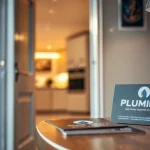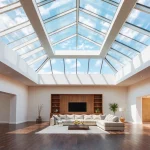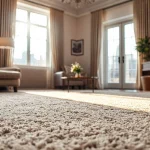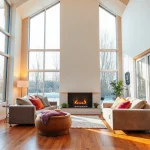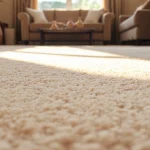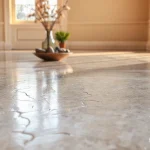Importance of Natural Light in Basement Conversions
Incorporating natural light into basement conversions significantly enhances both the livability and overall mood of the space. Natural light is proven to elevate mood and increase comfort levels, making basements more inviting and functional. In fact, a well-lit environment can transform previously underutilized areas into desirable living or working spaces.
The energy efficiency benefits derived from natural lighting should not be underestimated. By reducing the need for artificial lighting during daylight hours, homeowners can potentially lower energy consumption, thereby leading to cost savings. Additionally, dependence on electricity is minimized, aligning with sustainable living principles.
Also to discover : Top Strategies to Keep Your UK Basement Flat Mold-Free
Moreover, integrating ample natural light can increase property value. Well-lit spaces often attract potential buyers who appreciate the aesthetic and lifestyle benefits. The perceived increase in space and comfort can justify a higher market valuation, which is an important consideration for homeowners looking to sell in the future.
Overall, strategically planning for natural light in basement conversions brings considerable benefits beyond mere brightness. It’s an investment in both quality of life and property value, ensuring that these spaces are both pleasing and practical. To achieve optimal results, it’s crucial to consider various methods and solutions that facilitate the entry of natural light.
In parallel : Seamlessly Incorporating Smart Home Technologies into Your UK Grade II Listed Building
Windows as a Vital Component
Incorporating basement windows significantly enhances natural light, making them an essential element in any conversion project. There are several types of basement windows available, including egress, awning, and hopper windows, each offering varying levels of light entry and ventilation. Selecting the right window type depends on both the structural limitations of the basement and the desired outcome of the conversion.
Choosing appropriate glazing options is particularly crucial in the UK’s diverse climate. Double or triple glazing can improve energy efficiency by providing better insulation, while features like low-emissivity coatings can maximize the penetration of natural light while minimizing heat loss.
When installing windows in a basement conversion, adhering to UK regulations is essential. This involves understanding aspects like window size and placement, ensuring safety, and meeting fire escape requirements. Local regulations may dictate specific criteria to fulfil when adding or modifying basement windows.
Conscientiously selected windows and glazing not only enhance natural light but also contribute to the overall energy efficiency and aesthetic appeal of a conversion. Informed choices about window type and glazing ensure compliance with building standards and enhance the comfort and value of the transformed space.
Maximizing Light with Skylights
Using skylights can dramatically increase the amount of natural light in a basement conversion. They represent a smart solution for letting in more daylight, particularly when conventional windows are inadequate. Roof windows and light tubes are two popular skylight options that can suit different types of basement layouts. Roof windows provide direct light from above, while light tubes capture sunlight from a roof-mounted dome and channel it through a reflective tube. This flexibility in design means homeowners can select a solution tailored to their specific needs.
When considering skylights, it’s important to reflect on installation aspects and potential cost factors. For instance, structural considerations include positioning for maximal light intake without compromising the building’s integrity. Costs can be influenced by the chosen design and complexity of the installation process. Although the initial investment might be significant, the benefits often outweigh the expenditure due to the increased appeal and functionality of the space.
In the UK, skylights also help reduce the reliance on artificial lighting, aligning with sustainable living. The enhanced illumination can significantly transform a basement into a welcoming environment, enriching the mood and accessibility of what would otherwise be an underlit area.
Utilizing Light Wells
Light wells serve as crucial installations in enhancing natural light within basement conversions. These below-ground light sources are designed to capture and channel daylight into sublevel spaces, making them more vibrant and welcoming. The construction of a light well involves excavating a space adjacent to basement windows, allowing unimpeded sunlight access to interior areas.
For best results, designing effective light wells requires careful planning. Considerations include the optimal size and depth to maximize light capture while maintaining structural integrity. Choosing a reflective surface for the light well’s walls can further amplify daylight penetration.
From various case studies, successful basement conversions utilizing light wells demonstrate a noticeable improvement in the ambiance and usability of basement spaces. For example, some London homes have embraced light wells to transform formerly dim basement rooms into bright, pleasant environments, achieving enhanced livability.
Installation tips emphasize ensuring proper drainage to prevent water accumulation, which could undermine structure and indoor air quality. Including such considerations in the design phase is essential to avoid costly adjustments later.
Overall, light wells are an investment in both aesthetics and practicality, offering a transformative solution for restricted lighting scenarios often faced in basement spaces.
Reflective Surfaces and Color Schemes
Incorporating reflective surfaces and strategic colour schemes can significantly amplify the impact of natural light in basement conversions. By using materials with high reflectivity, such as glossy tiles, mirrored accents, or metallic finishes, light is efficiently bounced around the room, enhancing overall brightness. These surfaces transform even limited light sources into effective room illuminators.
Choosing the right colour scheme further augments the effect of natural light. Light, neutral tones such as whites, soft greys, and warm beiges are recommended to make the space appear larger and brighter. Colours like blues or greens can provide a soothing atmosphere while maintaining a light-enhancing effect.
Collaborating with interior designers ensures that both aesthetic and functional aspects are considered, achieving a harmonious balance between style and practicality. Designers can recommend how to best mix reflective surfaces with colour schemes to tailor the space to personal preferences and lifestyle needs.
By thoughtfully selecting materials and colours, homeowners can achieve a substantial improvement in perceived light without altering existing structural elements. This approach proves particularly advantageous in spaces where introducing new light sources may be impractical or cost-prohibitive.
Planning Regulations and Considerations
Navigating the maze of planning regulations is crucial for a successful basement conversion. Understanding the necessary building codes and UK legislation ensures your project aligns with all legal requirements, safeguarding your investment. Primarily, regulations address structural integrity, safety, and aesthetic impact. Before proceeding, securing planning permission is often required, especially if alterations affect the building’s footprint or façade.
Compliance involves specific guidelines concerning light maximisation. For instance, regulations may stipulate window dimensions or the inclusion of emergency escape routes, essential when installing basement windows or skylights. Adhering to these codes not only ensures safety but can also enhance the natural lighting of your space, elevating overall living conditions.
Navigating permits and approvals might seem daunting. However, proficiency in UK legislation assists in avoiding potential setbacks. Collaborating with professionals familiar with these protocols can streamline the process, balancing legal compliance with design aspirations. Crowning your project with an appropriate understanding of regulations will cultivate an inviting, compliant, and optimally lit living area.
Knowing these considerations lays the foundation for an efficient and successful basement conversion, ensuring that the enhancement of natural light aligns with legislative stipulations, uncompromising the aesthetics and safety standards.
DIY Strategies for Enhancing Natural Light
For those embarking on basement conversions, DIY techniques offer practical solutions to boosting natural light without breaking the bank. By integrating affordable and effective modifications, you can significantly enhance your space’s brightness and appeal.
Start small by implementing lighting tips such as painting walls in light, reflective colours. Whites, pastels, or soft neutrals can dramatically alter perception by reflecting existing light more effectively. Incorporating mirrors or glossy surfaces can further amplify light, scattering it throughout the room.
Another DIY approach involves strategically utilising home improvement tactics like installing light-enhancing fixtures. Consider using track lighting in conjunction with traditional light sources to efficiently distribute light. Opt for daylight bulbs to mimic natural light, enhancing the ambiance even when sunlight is insufficient.
For more adventurous DIYers, introducing light-coloured flooring can combat darkness in basements effectively. Employing these materials can perpetuate a bright and open feel.
These cost-effective methods can transform any basement into a welcoming, well-lit environment. With a little creativity and thoughtful implementation, significant improvements can be achieved, minimising the need for professional intervention and maximising the functionality of your basement on a budget.
Case Studies of Successful Basement Conversions
Exploring case studies of remarkable UK basement conversions illuminates how effectively integrating natural light can transform a space. These successful examples offer practical renovation inspiration, showcasing innovative design choices that maximise light intake and enhance livability.
In one notable case, a Victorian townhouse in London achieved a stunning transformation by incorporating large light wells and strategically placed skylights. This design choice not only introduced abundant natural light but also established a seamless connection between the indoor and outdoor environments. The outcome was a balanced, inviting living space brimming with brightness and charm.
Another case involved a contemporary home where reflective surfaces and light tubes were employed to optimise illumination in the basement. Mirrors and light-coloured walls combined with technologically advanced light tubing systems, effectively scattered natural light throughout the space, resulting in a vibrant, airy atmosphere.
The lessons learned from these successful projects highlight the importance of prioritising natural light in any renovation. While each project varied in scope and style, their emphasis on creative solutions for lighting issues serves as valuable guidance for future developments. By studying these examples, homeowners and designers alike can draw inspiration and practical ideas to enhance their own basement projects.

